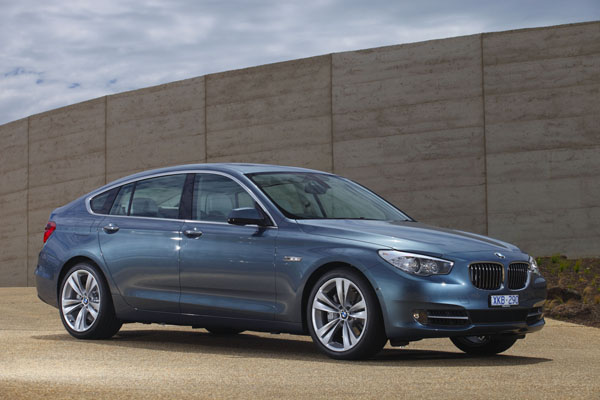
BMW 5 Series is a prestige sold as a midsize sedan or station wagon. It leans in the sporting direction in the endless compromise between sports and luxury. Handling is brilliant due to the near-perfect weight distribution that’s the result of rear-wheel drive and the positioning of the engine well back under the bonnet.
Yet this handling is achieved without upsetting comfort to any real extent. Some bad Australian roads may catch out the suspension out, but it generally makes light work of rough surfaces. Big distances can be covered in the outback and leave the occupants feeling relaxed at the end of the day.
A downside is that older 5 Series are rather smaller inside than you might expect for this class. That’s chiefly because of the rear-wheel drive and the gearbox is beside your feet due to the engine’s rear mounted position.
The virtually all-new fifth generation of April 2010 is better in the rear passenger compartment, but it’s still wise to test for space if you’re aiming to carry tall people back there.
Most BMW 5 Series sold in Australia are four-door sedans, but in recent years station wagons, ‘Touring’ in BMW-speak have increased in sales. The wagons have a reasonable cargo capacity; but as is often the way in the boutique station wagon class the slope of the rear end does restrict bulky objects.
BMW has a large range of SUVs, or SAVs (Sports Activity Vehicles) as it prefers to call them. The ongoing upsurge in SUV sales means you can possibly consider them rather than wagons. Your call…
Big capacity BMW straight-sixes are amongst our all-time favourite powerplants, providing effortless performance and a willingness to rev that’s delightful.
However, BMW has followed the other European makers in have turbocharged four-cylinder units that have lots of torque. This has been done to meet emission regulations.
Though the BMW engineering to minimise turbo lag is impressive they still don’t provide the near instantaneous response we have loved in BMW non-turbo engines for many years.
Then there are the superb V8 units. Big on power and torque they are much loved by enthusiastic drives. Their fuel consumption isn’t as high as you might anticipate but they do like a drink if you get stuck into them.
Turbo-diesels have become increasingly popular over the years in Australia, though we were much slower to adopt these than our European cousins.
Turbo lag is better than average for this class, but can still be a nuisance at times in older engines. Once the lag has gone and you’re into the big midrange torque, you will love the seemingly endless grunt.
Spare parts and repairs are about average in price for a vehicle of this type and prestige rating, which means they can damage your budget if something goes wrong.
This is certainly not a car for the amateur mechanic to attempt to work on. By all means you can have a go at the minor items, but use qualified people for anything else, particularly anything related to safety.
BMW is well represented in most major areas in Australia. Some factory-trained BMW mechanics have since left the company and set up independent repair shops. They may not have the same factory contacts as the official dealers, but are often highly regarded by owners.
Insurance is often expensive because of the cost of parts and the need to use quality repairers. If you are moving up from a more mundane car to a BMW for the first time, shop around on premiums before becoming over-committed.
WHAT TO LOOK FOR
Look over the car for body damage and signs of previous repairs.
Be sure the engine starts virtually immediately and idles smoothly from the moment it fires up, even when it’s stone cold.
Diesels aren’t as quick to kick over as petrols, but if you suspect it’s too slow get a qualified diesel technician to check it. Preferably at their workshop rather than at the dealer’s yard.
The engine should accelerate without hesitation and not blow smoke from the exhaust, no matter how hard it is worked.
Automatic transmissions should change smoothly and, except for some changes on big throttle openings, should be all but impossible to feel.
Make sure all electronic and electrical items are operating correctly. Use the owner’s handbook to say what does what. These are among the most complex cars on the planet so big money could be lost if problems arise.
Check on the insides of the front wheels and brake callipers for excessive brake-pad dust. That may be a sign of a hard driver.
HOW MUCH?
Expect to spend from $12,000 to $17,000 for a 2010 BMW 525i or a 2013 528i; $18,000 to $25,000 for a 2011 535i Touring; $22,000 to $30,000 for a 2013 520d Touring; $26,000 to $35,000 for a 2012 550i Coupe; $34,000 to $45,000 for a 2014 535d Luxury Line; $35,000 to $46,000 for a 2017 530i M Sport; and $46,000 to $61,000 for a 2016 5 Active hybrid; $52,000 to $69,000 for a 2017 530e PHEV Luxury Line; $69,000 to $91,000 for a 2018 540i Luxury Line.
CAR BUYING TIP
Dreaming of moving up to a highly regarded prestige car? Make sure to keep plenty of money aside in case of emergencies.
RECALLS: To browse recalls on all vehicles go to the ACCC at: www.productsafety.gov.au/products/transport/cars/